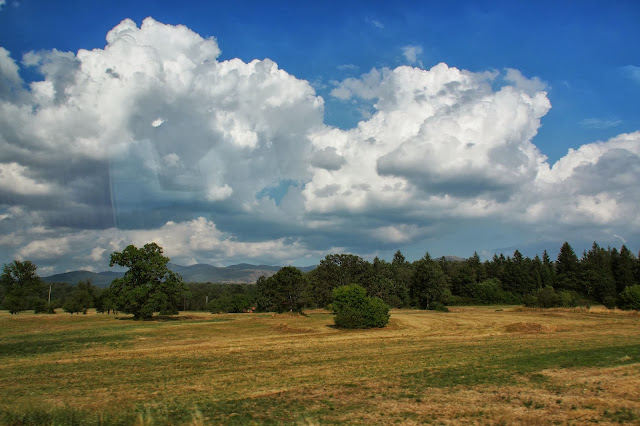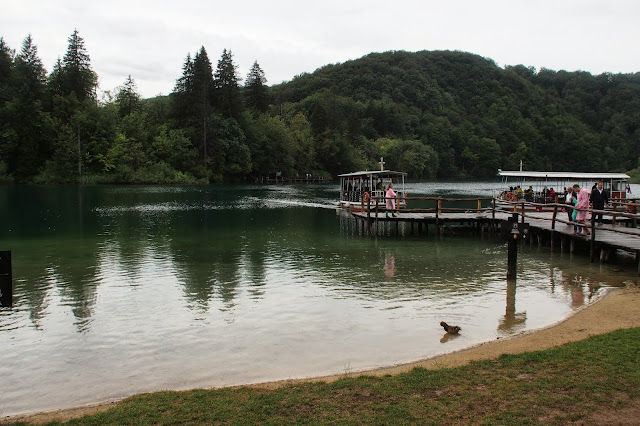After visiting the Postojna caves in Slovenia, we were driven back to Croatia, where we were taken to the famous 73,350- acre Plitvice Lakes National Park (Plitvička jezera), the oldest national park in Southeast Europe and the largest national park in Croatia situated along the north-south D1 Zagreb-Split national route joining the interior of Croatia to the Adriatic, some 34 miles away.
Founded in 1949 in the mountainous karst area of central Croatia bordering Bosnia-Herzegovina, it's been one of UNESCO World Heritage sites since 1979 with more than 1.2 million visitors per year. Commonly referred to as the "16-Lakes" in Chinese tourist literature, its cascading lakes with an area of 2 square KMs, descend from 2,100 feet to about 1,650 feet and are formed by the confluence of several small surface and some subterranean karst rivers straggling over a distance of some 8 KM and are broken up into numerous natural dams of travertine formed by the joint action of moss, algae, bacteria, sun, air and water, which accumulate and grow on top of each other at the rate of about 0.4 inch per year.The water from the lowest lake flows into the Korana River. Like the Jiuzhaigou of Sichuan, the lakes are renowned for the vivid colors of its water from azure, to green to yellow depending on the season, the color of the vegetation, the quantity of minerals, organisms, the weather and the angle of sunlight. It got its name from a Croatia word "pličina" or "plitvak", meaning "shallow basins filled with water." but others argue that it got its name from the River Plitvica which flows into it but a nearby village also bears the same name.
The 16 lakes, formed at the end of the ice age about 12,000 to 15,000 years ago are roughly divided into 12 Upper Lakes (Gornja jezera) and the four Lower Lakes (Donja jezera).The two largest lakes, Prošćansko jezero and Kozjak jezero, cover about 80 percent of the overall water body area. These lakes are also the deepest, with a depth of 37 and 47 metres (121 and 154 ft) respectively. On Lake Kozjak, low-noise and ecologically-friendly electric boats are being used. None of the other lakes in the park are more than 25 metres deep. On average, the lakes got some 60 inches of rain per year, usually heaviest in spring and autumn and have a humidity of some 82 percent, with temperatures ranging from 2.2° C in January to 7.9 °C in July and August but can rise to 17.4 °C on the hottest days but it averages around 9 °C over the year as is the temperature of of its spring water but within the rivers and lakes, the water temperature may rise up to 20 °C in summer. In December and January, the lakes freeze over.
The 16 Lakes are heavily forested, mainly with beech, spruce, and fir trees, some up to 700 years old. With its humidity and varied landscapes, the area is covered with vegetation, with more than 1,267 different kinds of plants, 75 of which peculiar to the area, a great number of them being protected by law. Because no industry is allowed to be established in the area, so it has pretty much retained its original character, hence huge number of animals, birds, insects etc. thrive in the area. Within the national park area there are 55 different species of orchids, 321 species of butterflies ( a fifth of which are day-fliers) and has brown bears, wolves, eagle-owls, golden eagles, lynx, wild cats, and capercaillie. with about 50 species of mammals and 20 different kinds of bats. The Plitvice Lakes are also home to the endangered autochthonous trout. But there are also minnows (Phoxinus phoxinus), rainbow trouts, even European chub and common rudd and crayfish in the caves and rivers and lakes.
The Plitvice Lakes area has been inhabited for thousands of years, in turn by Illyrians, Thracians, Celts, Japods, Romans, Avars, Slavs, and Turks. Under Julius Caesar the region was incorporated as the province of Illyricum into the Roman Empire whilst its neighbor tribes of the Pannonians, the Liburnians and Dalmatians were united into the province of Dalmatia Then the area was taken over successively by the Ostrogoths, then in the sixth century, Avars settled in this region, which were accompanied by the Croats, who eventually defied Avar control and settled permanently in this region. In medieval times, frequent attacks by Mongols posed a permanent threat to the settled population.The lakes formed part of the medieval kingdom of Croatia which in 1102 elected to be in personal union with Hungary. In 1493, not far away from the Plitvice Lakes a decisive battle took place between the Austrian Empire and Ottoman Empire, the Battle of Krbava Field, when the entire Croatian nobility were wiped out and the Turks advanced far into Croatia and Hungary. In 1527, at the parliament on Cetin the Croatian nobility elected the Habsburg monarch Ferdinand, Archduke of Austria as the new King of Croatia so as to get protection from Turkish advances but still in 1528, the area became part of Ottoman Empire and did not revert to Austrian rule permanently until 1878 For a short period 1805-1814, during the French Revolution, the area became part of the French Empire under Napoleon Bonaparte. In addition to the native Croats already inhabiting the region and serving in the Austrian military, many central Europeans migrated to the region as did Serb Orthodox refugees fleeing Ottoman repression, who were given refuge in the abandoned areas in exchange for military service. The entire population of the military frontier, particularly the so-called frontiersmen, had the duty to protect this area of permanent unrest and terrible destruction. The region once also used to be called the garden of the devil (hortus diabolus).
Already in 1861, an accommodation for travelers was erected at Velika Poljana. The local population called this accommodation the Emperor's house, since imperial military officers used to reside in this location. For the visit of Crown Princess Stéphanie of Belgium, the wife of Crown Prince Rudolf of Austria in 1888, the Plitvice Lakes and their surroundings were prepared for tourism for the first time in history. Two paths still bear the names of the daughters of the Emperor Franz Joseph: "Stephanie's Path" (Croatian: Štefanijin put) and "Dorothea's Path" (Croatian: Dorotejin put).In 1916, during the First World War, the Croatian parliament in Zagreb passed the Law on the Protection of the Plitvice Lakes but it did not contain adequate protective measures and is thus not regarded as the official founding declaration of the national park. It was only after the end of the Second World War, on April 8, 1949, that the Plitvice Lakes were declared a national park area and rigorous nature protection measures were established. During the 1980s, tourism was booming in Yugoslavia. Plitvice Lakes National Park soon became one of Yugoslavia's hottest tourist attractions. The beginning of the 1990s, however, marked another great turning point in the history of this national park. In March 1991 it became the scene of the Plitvice Lakes Incident (also called the "Plitvice Bloody Easter"), the first armed confrontation of the Croatian War of Independence that resulted in fatalities. The park was held by local Serb rebels backed by Slobodan Milošević and the Yugoslav People's Army (JNA) as part of the self-proclaimed "Republic of Serbian Krajina" during the conflict and suffered some damage in the process, with hotels and other facilities being used as barracks. During the period under the control of Serb forces loyal to Belgrade, Croats were ethnically cleansed from the region systematically. The region was retaken by the Croatian Army in August 1995 during Operation Storm, which ended the Croatian war. The number of tourist visiting the Lakes steadily increased from about 1000 in 1894 to half a million in 1989 and to more than 1 million in 2011.
There are just a few comparable kind of landscape in the rest of the world: Lake Rastoke (Slunj) at the Krka National Park or at the rivers Una and the Pliva in Bosnia-Herzegovina; the Band-e Amir lakes within the Hindu Kush mountain range; calc-sinter formation processes that have not emerged along a river flow can now be observed at the Mammoth Hot Springs within Yellowstone National Park (USA) or at Pamukkale in Turkey and also at Jiuzhaigou in the PRC.
The countryside from Slovenia back to Croatia
Everywhere you go, you find farmers growing maize, canola, olives etc or graze cattle or sheep.
a German style church, relic of Hapsburg rule
The storm clouds were gathering before we reached the Plitvice Lakes. We just hope that it wouldn't rain.
A map of the Plitvice Lakes. We only had time to visit the lower lakes.
Our first view of one of the lakes.
How clear is the water!
Moss and wild mushrooms growing on the bark of one of the trees there
Some of the high waterfalls
The waters were green, just like those in Jiujiagou
Reflections of the trees on one of the lakes
The first lake we saw
We could walk across from one side of the lake to another
Fishes in the shallow water
Next to the bridge were rushes
Water cascading down
You can see the travertine forming
The lake seems filled with fishes
Soon after we arrived, the rains came and the fishes hid under the tree.
You can see people on raincoats and hoods
But the water was beautiful
raindrops dripping into the water from the leaves above
Reflection of leaves on the water: how different from the surface of the puddle beside it!
Water flowing over the rushes
The surface of the rocks were filled with mosses, old and new
The cataracts are thick with vegetation
Everywhere you find such platforms
The leaves almost touch the surface of the lake
The exposed surfaces of the rocks were covered by vegetation
Water rushing down the lake beside the path
Trees on an island on the lake where we took the pollution free lake ferry back to where we started
Some rowing boats for the use of workers there. At the back is the ferry we were to take.
Workers on the boats
The landing area
I like this tree: so full of life.
its bark is full of new mosses
Firs, spruce, beech growing in great abundance
Our ferry pier
There were ducks everywhere
Another small waterfall on the opposite side of the lake with ducks having fun in the foreground
I like the way the water changes colors
Mottled leaves in the park where we had our lunch
Some leaves were already turning yellow
The restaurant to cure us of our famish after all the walking and the shivering in the cold rain
A bee on the window pane wanted to share our meal?
Our lunch: roast piglets potato and bread
Our dessert
Flowers outside the restaurant
More flower on the restaurant terrace
The raincoat of one of our tour members, another girl crazy about photography: a reminder of our desperate attempt to take cover beneath an overhanging rock at the side of the path.
(To be cont'd)



















































沒有留言:
張貼留言